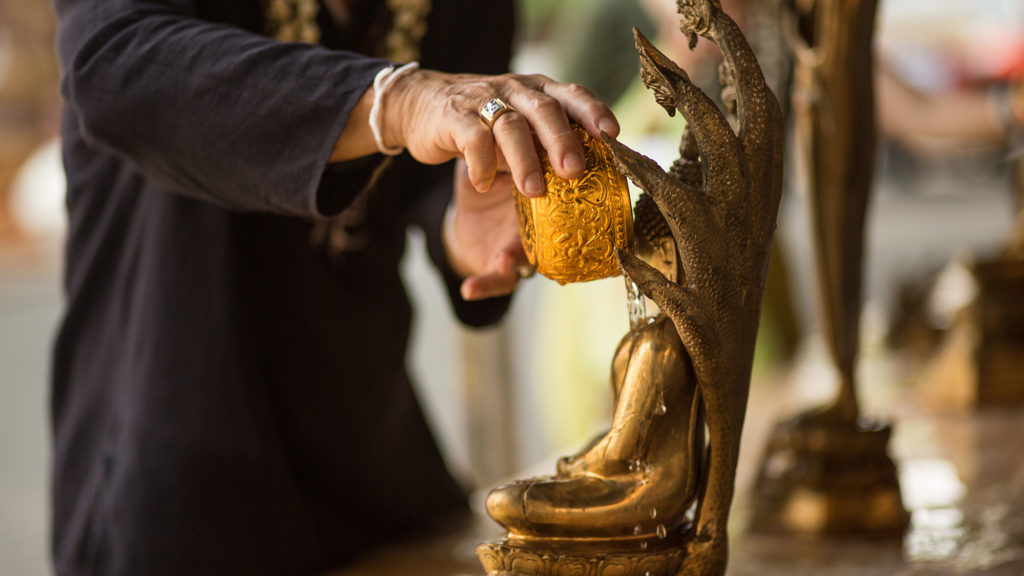
Forgiveness, restoration, renewal—human hearts long to be washed clean and given a fresh start. The yearning for spiritual renewal is central to the celebration of Songkran in Southeast Asia.
The word Songkran finds its roots in the Sanskrit language. According to the lunar calendar, Songkran falls in April, marking the Thai New Year and the passage from one astrological sign into another. In the Buddhist faith, Songkran is regarded as a time of renewal.
The desire for a fresh start is reflected on the first day of the festival when families clean their houses from top to bottom. They throw away anything they believe has caused them bad luck throughout the year. After purging those things with bad associations—bad karma—they seek to make merit in a variety of ways throughout the festival. These acts of devotion are offered as appeasement to the spirits that look upon them as a way of balancing bad deeds with good ones.
Merit making is an integral part of the Buddhist faith. Alms giving, reverently pouring water over a monk’s head, washing the Buddhist idols, building sand towers at a Buddhist Temple, even purchasing birds to release back into the wild—all these activities are associated with making merit during Songkran. But Thai Buddhists can never be sure just how much merit they’ve attained, or if it will ever be enough to help them break through successive cycles of reincarnation to the ultimate goal of reaching Nirvana—liberation from the cycle of rebirth. They are forever returning, but never really made new.
As you reflect on these photographs of Songkran celebrations in Thailand, pray Thai Buddhists will find spiritual renewal in Christ.

Photo by Miles Parry.
In anticipation of Songkran festivities, the streets rapidly fill with spectators gathered to enjoy the parades and traditional dances. Northern Thailand was once known as the Lanna Kingdom. These young women adorned in traditional Lanna dresses dance as a part of the opening celebration.

Photo by Elle Graham.
Two dancers perform a traditional dance depicting a story of a hunter and a stag in front of the Three Kings monument in Chiang Mai, Thailand.

Photo by Miles Parry.
Lines of Buddhist monks clothed in saffron-colored robes slowly walk through the crowd receiving alms from people looking to appease their sins and make merit for the year. The bulging white bags in the center reveal the abundance of gifts these holy men receive.

Photo by Liam Mark.
This man represents one of many who give gifts of money or food in hopes of receiving good merit to offset bad luck. Many give wholeheartedly, but all lack assurance of salvation through their good deeds.

Photo by Miles Parry.
With the opening ceremonies of Songkran, many gather to bless the monks and receive their blessing for the new year. Even high officials representing the Thai government pay respect to monks during this time. Their public devotion demonstrates how Buddhism is interwoven through Thai culture.

Photo by Miles Parry.
A vendor sells bamboo cages of birds to be released to make merit. Each cage sells for 200 Thai baht (a little less than $6 US).

Photo by Elle Graham.
These women in traditional Thai dress participate in the ancient tradition of releasing caged birds in hopes to accrue merit for freeing a life.

Photo by Liam Mark.
At Buddhist temples, patrons perform rituals like washing Buddhist idols, hoping this will bring them more success and fortune in the coming year. The holy water poured over these idols has been blessed by the monks and contains perfumes and flowers. It represents the cleansing of the old year and beginning of the new year.

Photo by Elle Graham.
Altars are filled with lit candles during Songkran celebrations. Many Southeast Asians believe their lives are controlled by the spirits around them. They burn candles as an attempt to appease the spirits who are actively influencing their lives

Photo by Miles Parry.
On the first afternoon of the holiday, a Nang Songkran—Miss Songkran—is chosen to reign over the festival. She is led in procession seated on an animal figure representing the day of the week on which Songkran begins that year. The seven beasts for the week are derived from an ancient Hindu legend of a god who lost a bet and so, also, his head. His seven daughters ensured that his memory lived on by parading the head once a year. This procession continues as part of the Songkran festival. The severed head, however, has been replaced by the seven creatures, each corresponding to one of the daughters.

Photo by Victor Xingh.
Miss Songkran, pictured above, pays homage to the ancestors in a Buddhist temple.

Photo by Liam Mark.
During Songkran, people who have moved away return to their hometowns and give honor to senior members of the family. In a beautiful unity ceremony, the younger generation humbly kneels before the elders and washes their hands with water as a sign of respect and gratitude, and also as a blessing.
Some Thai Christians observe the tradition of blessing elders in their families and churches, continuing the tradition in a way that is biblically faithful. Christian believers use the blessing ceremony as an opportunity to pray for one another. In the picture above, a Christian pastor prays for a member of his congregation.
May the eyes of Thai Buddhists’ hearts be enlightened so they can see the truth of the gospel, the source of spiritual renewal and the only hope of eternal life.
Songkran can be a marvelous opportunity for Christians to share about the hope and promise of new life in Christ (2 Cor. 5:17). Learn more about Songkran as a gospel opportunity here.
Miles Parry, Elle Graham, Liam Mark, and Victor Xingh are media specialists serving with the IMB.

